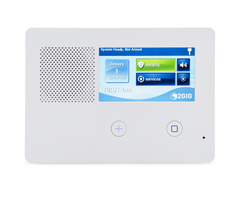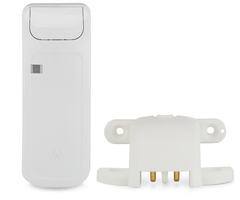Just like any residence, an apartment is at-risk for a burglary or break-in. An unlocked door or a shattered window offers an easy entrance for an intruder. With an apartment security system you can be ready if this occurs. But picking a system can be daunting with so many options available!

Luckily, Alarm Grid is here to help you pick the best apartment alarm system for your needs. A good apartment security system usually features a wireless panel that can be installed using a desk or table stand. This will allow you to easily take the system with you when you move, and it will prevent you from having to drill holes in the wall. The wireless sensors can similarly be mounted using double-sided foam tape, and they can be easily removed if you relocate. You may also want the panel to include some cool smart home automation features to make your life more convenient.
It is strongly recommended that you select an apartment security system that is non-proprietary. This means that you will be able to take it to a new monitoring company if you cancel your current service. A great option is to go with a DIY no-contract alarm monitoring company like Alarm Grid. Our company does not charge you anything to start or stop monitoring service, which is really convenient if you ever need to take a month off of service while you are moving. We also offer systems that are super quick and easy to install without having to hire a professional installer!
With that in mind, we have our picks for the top 5 apartment security systems of 2019. All of these systems work great if you are looking to set up your own apartment alarm system that you can take with you if you decide to move later on. These systems are all very easy to use, and you can set them up in a matter of minutes. Let's check out the systems!

Interlogix has long been known for their cost-effective systems. While they are ceasing operations at the end of the year, they are leaving us with a very good system. The Interlogix Simon XTi-5i is great if you need a no-frills alarm panel for basic operation. It has a 5-inch touchscreen display, support for up to 80 wireless zones, and some great communicators available, including some dual-path options. Adding a communicator will also make the system Z-Wave ready. You can even choose from an exclusive lineup of Interlogix Encrypted Sensors to add to the system. And for apartments, there is an excellent table stand you can buy for the system!
 The 2GIG GC2e is the current entry-level option from 2GIG. It packs some great features into a small package, and it provides some nice upgrades over its 2GIG GC2 predecessor. With the GC2e, you will enjoy a larger 5-inch touchscreen, built-in Z-Wave Plus, and support for 2GIG eSeries Encrypted Sensors. Some other specs include support for up to 60 wireless zones and 64 different user codes. Remember to add a cellular communicator so that you can use with system for monitoring service through Alarm.com. And don't forget about the desk mount!
The 2GIG GC2e is the current entry-level option from 2GIG. It packs some great features into a small package, and it provides some nice upgrades over its 2GIG GC2 predecessor. With the GC2e, you will enjoy a larger 5-inch touchscreen, built-in Z-Wave Plus, and support for 2GIG eSeries Encrypted Sensors. Some other specs include support for up to 60 wireless zones and 64 different user codes. Remember to add a cellular communicator so that you can use with system for monitoring service through Alarm.com. And don't forget about the desk mount!
 2GIG offers an impressive high-end security system with their GC3e. It still retains a lot of similarities to the discontinued 2GIG GC3, while offering some new upgrades in its own right. Namely, the panel now supports the 2GIG eSeries Encrypted Sensors, and it offers a fresh redesign over its predecessor. Returning features to the GC3e include a 7-inch touchscreen, support for up to 100 wireless zones, 100 user codes, partitioning, integrated WIFI, and built-in Z-Wave Plus. Note that you will still need a cellular communicator to monitor the system and use it with Alarm.com. Interestingly, the system uses the same desk mount as the 2GIG GC2e.
2GIG offers an impressive high-end security system with their GC3e. It still retains a lot of similarities to the discontinued 2GIG GC3, while offering some new upgrades in its own right. Namely, the panel now supports the 2GIG eSeries Encrypted Sensors, and it offers a fresh redesign over its predecessor. Returning features to the GC3e include a 7-inch touchscreen, support for up to 100 wireless zones, 100 user codes, partitioning, integrated WIFI, and built-in Z-Wave Plus. Note that you will still need a cellular communicator to monitor the system and use it with Alarm.com. Interestingly, the system uses the same desk mount as the 2GIG GC2e.
 There are many reasons why we can confidently say that the Honeywell Lyric Security System is one of the best panels on the market today. It is one of very few panels (and currently the only one on this list) that can support Apple HomeKit. The Lyric offers a very impressive 128 wireless zones, 64 user codes, built-in Z-Wave, and a 7-inch touchscreen. You will have no trouble filling up the zones with Honeywell SiX Series Sensors, which offer military-grade 128-bit encryption! Other features include a built-in 2MP camera for disarm photos and ten (10) different chime settings.
There are many reasons why we can confidently say that the Honeywell Lyric Security System is one of the best panels on the market today. It is one of very few panels (and currently the only one on this list) that can support Apple HomeKit. The Lyric offers a very impressive 128 wireless zones, 64 user codes, built-in Z-Wave, and a 7-inch touchscreen. You will have no trouble filling up the zones with Honeywell SiX Series Sensors, which offer military-grade 128-bit encryption! Other features include a built-in 2MP camera for disarm photos and ten (10) different chime settings.
The panel also comes with built-in WIFI, and unlike the other systems on this list, it can be monitored across IP only. Not only does this mean you do not need to add a communicator, you can use the Lyric on a less expensive IP-only monitoring plan. This is perfect for users looking to cut-down on monitoring costs. But you can still add a Lyric Cellular Communicator if you want. The Honeywell LCP500-DK is the recommended desk mount.

There is so much to like about the Qolsys IQ Panel 2 Plus as an apartment security system. It is sleek and modern with its thin profile and beautiful 7-inch touchscreen. You will love its built-in glass break sensor, integrated 5MP camera, and support for up to four (4) partitions. This is also the only system on the list that is dual-path ready right out of the box, as it has both an LTE communicator (AT&T or Verizon) and a WIFI card. You can even live-stream compatible Alarm.com Cameras right from the panel once you have connected the system with Alarm.com.
Other features include built-in Z-Wave Plus technology for smart home integrations, as well as integrated Bluetooth for optional automatic disarming. If that weren't enough, the system offers support for PowerG Sensors, as well as one legacy frequency (319.5 MHz, 345 MHz, or 433 MHz). The PowerG support is particularly useful, as PowerG Sensors utilize military grade 128-bit AES encryption and a wireless range of up to 2,000 feet away from the panel. This is way further than you will likely need in an apartment, but it's still cool nonetheless! A standard desk mount comes included with the system, but you can also purchase the Qolsys IQ Stand if you want something a little more robust. The Qolsys IQ Panel 2 Plus is without a doubt the pinnacle of apartment security systems in 2019.
If you need help choosing a system, or if you want to learn more about the alarm monitoring plans offered from Alarm Grid, then please reach out to us! The best way to contact us is to email support@alarmgrid.com. You are also welcome to call us at (888) 818-7728. Just keep in mind that our regular business hours are from 9am to 8pm ET M-F. We look forward to hearing from you!


 Whether you love it or hate it, you likely know what winter brings for most of the country. There will likely be some cold weather and snow. The holiday season will also be happening soon, and presents will be sent out. Although Alarm Grid doesn't have anything to help you shovel your driveway or defrost your car windshield, we do have some important accessories that will help ensure that your winter season is a good one.
Whether you love it or hate it, you likely know what winter brings for most of the country. There will likely be some cold weather and snow. The holiday season will also be happening soon, and presents will be sent out. Although Alarm Grid doesn't have anything to help you shovel your driveway or defrost your car windshield, we do have some important accessories that will help ensure that your winter season is a good one.


 Amazon is going to be busier than ever this holiday season delivering packages across the country. With packages being delivered faster than ever, package thieves are becoming a serious concern. Stolen presents won't lead to a merry holiday season, especially if you don't have any evidence of the crime. This is why you should definitely install a doorbell camera.
Amazon is going to be busier than ever this holiday season delivering packages across the country. With packages being delivered faster than ever, package thieves are becoming a serious concern. Stolen presents won't lead to a merry holiday season, especially if you don't have any evidence of the crime. This is why you should definitely install a doorbell camera.




 The 2GIG GC2e is the current entry-level option from 2GIG. It packs some great features into a small package, and it provides some nice upgrades over its
The 2GIG GC2e is the current entry-level option from 2GIG. It packs some great features into a small package, and it provides some nice upgrades over its  2GIG offers an impressive high-end security system with their GC3e. It still retains a lot of similarities to the discontinued
2GIG offers an impressive high-end security system with their GC3e. It still retains a lot of similarities to the discontinued  There are many reasons why we can confidently say that the Honeywell Lyric Security System is one of the best panels on the market today. It is one of very few panels (and currently the only one on this list) that can support
There are many reasons why we can confidently say that the Honeywell Lyric Security System is one of the best panels on the market today. It is one of very few panels (and currently the only one on this list) that can support 




